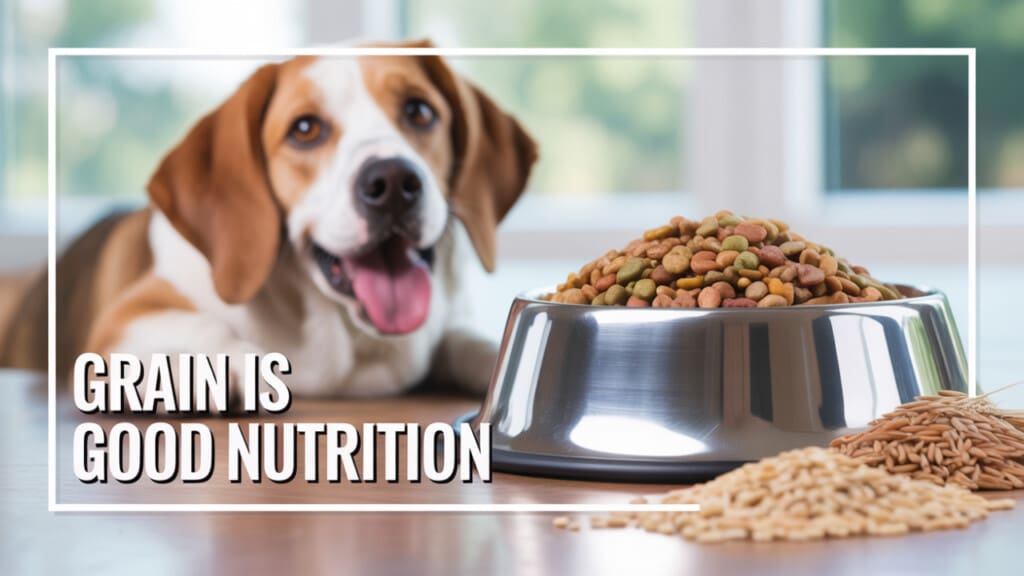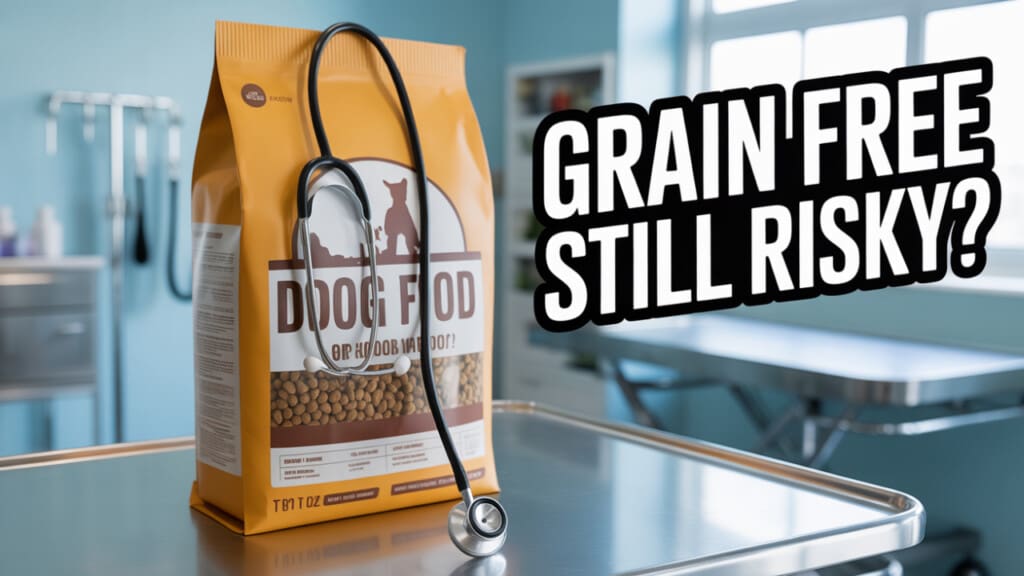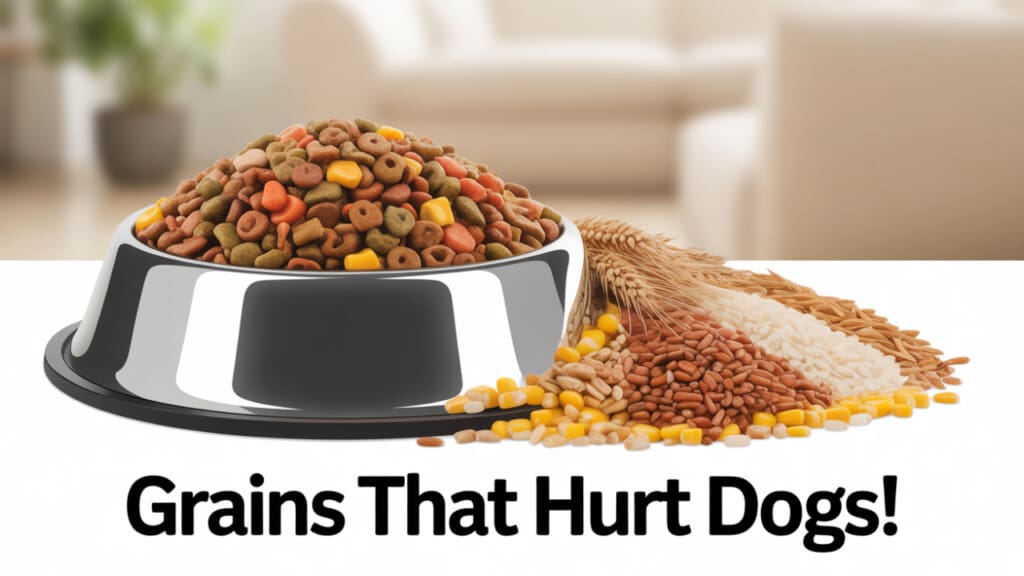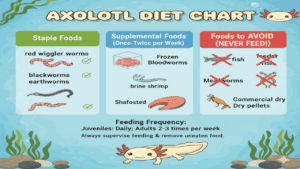Best Grains for Dogs: 2025 Buying Guide for Grain-Inclusive Dog Food with Vet Tips, Ingredient Warnings, and Common Mistakes to Avoid
You want to give your dog the very best? But standing in the pet food aisle, surrounded by shiny labels and buzzwords like “grain-free” or “ancestral,” it’s hard to know which bag to trust.
Right, we got you! If your dog doesn’t have a grain allergy, choosing a high-quality grain-inclusive dog food can actually support better digestion, provide steady energy, and reduce long-term health risks.
But… not all grains are equally suitable for your friend. And finding the best grains for dogs can be quite the chore.
A number of veterinary experts suggest that many budget dog foods rely on low-nutrient fillers like wheat middlings and brewer’s rice. These are ingredients that may trigger inflammation or allergies while offering minimal value.
On the other hand, whole grains like oats, millet, and brown rice are rich in fiber, promote gut health, and even support immunity in senior dogs and those with cancer.
So, do you want to avoid wasting money on the wrong formula? Keep reading then.
We’re about to expose common labeling tricks, vet-backed recommendations, and the surprising link between grain-free diets and heart disease risk in dogs.
Why Grain-Inclusive Dog Food Matters for Digestive Health and Balanced Nutrition

For quite some time now, the pet food aisle has been flooded with grain-free options. But is cutting out grains actually the healthier choice for your dog?
If your dog doesn’t have a specific allergy or grain sensitivity, the answer might surprise you. In fact, high-quality, grain-inclusive dog food can be a nutritional powerhouse. This is especially true when it comes to supporting digestion, energy balance, and long-term health.
Let’s break it down, shall we?
Whole grains like brown rice, oatmeal, and barley are rich in dietary fiber, which promotes healthy bowel movements and supports the growth of beneficial gut bacteria.
This is particularly important for dogs with sensitive stomachs, where even small dietary shifts can lead to digestive upset. Veterinarians say such grains offer “slow-burning” carbohydrates that release energy gradually, ideal for maintaining consistent energy levels throughout the day.
Then again, not all grains are created equal. One of the most common mistakes dog owners make is assuming any grain-inclusive formula is automatically healthy.
Lower-tier brands may rely on cheap fillers like corn gluten or wheat middlings, which lack the fiber and nutrients found in whole grains. These can spike blood sugar and may contribute to inflammation in some dogs.
You need to choose recipes that feature some of the best grains for dogs, such as sorghum, millet, and brown rice. They can make a world of difference in nutrient quality and digestibility.
Cost-wise, grain-inclusive diets are often more affordable than boutique grain-free blends, especially when comparing premium tiers.
And when you formulate them properly, they may even reduce vet visits over time by improving stool quality, lowering the risk of food-related GI issues, and enhancing coat health through better nutrient absorption.
So, let’s assume your dog doesn’t have a diagnosed grain allergy. You should definitely opt for a grain-inclusive dog food with well-sourced, whole grains. This could be one of the smartest choices you make, for their belly, budget, and vitality.
2025 Vet Update: Are Grain-Free Diets Still a Risk for DCM?

As of 2025, many vets and pet nutrition experts are still being careful about grain-free dog foods, especially because of concerns about heart health.
Back in 2022, the FDA said there was no clear proof that grain-free diets cause dilated cardiomyopathy (DCM)-a serious heart condition in dogs.
Still, ongoing research continues to point to a possible connection, especially in diets that are high in ingredients like peas and lentils (also known as pulses).
Dr. Lisa Freeman, a veterinary nutrition expert from Tufts University, explains:
In short, unless your dog has a medical reason to avoid grains, most experts agree that grain-inclusive diets are the safer option for heart health.
What Grains Should I Avoid in Dog Food?

Not all grains are well tolerated by our canine friend. So choosing the wrong ones could cost your dog more than just stomach trouble.
Grain-inclusive dog food can offer valuable nutrients. But certain grains are known for triggering allergies, causing inflammation, and providing little to no real nutritional benefit.
So, which grains should raise a red flag?
Many veterinary nutritionists say that low-quality fillers like corn gluten meal, wheat middlings, and brewer’s rice top the list of ingredients to avoid.
These are often used in mass-market or budget dog foods as cheap sources of carbohydrates. But they’re highly processed and stripped of most natural nutrients.
Even worse, they may spike blood sugar and irritate dogs with sensitive digestive systems or underlying inflammatory issues.
Take note. These grains aren’t always clearly labeled. Instead of saying “wheat byproducts,” the packaging might list them as “wheat flour” or “ground corn.”
Just because a grain sounds familiar doesn’t mean it’s beneficial. The lack of dietary fiber and the potential for grain allergies in dogs make these ingredients especially concerning for pets prone to skin issues, itching, or chronic gastrointestinal problems.
On the other hand, whole, minimally processed grains like brown rice, oatmeal, millet, and quinoa are safer and more nutritious options.
These, however, may cost slightly more per pound. But they typically result in better stool consistency, healthier coats, and fewer allergy flare-ups. And this will ultimately help you reduce your overall spend on vet visits and specialty treatments.
We know you want to protect your dog from unnecessary discomfort or hidden irritants. So always read the label and steer clear of filler grains. Choosing wisely today can prevent costly health issues tomorrow.
Best Grains for Dogs with Allergies, Cancer, and Sensitive Stomachs
Now, your dog suffers from allergies, a sensitive stomach, or even a chronic illness like (as much as we hate it) cancer. Choosing the best grains for dogs isn’t just important. It’s essential.
While grains often get lumped together in pet food debates, certain types can provide critical nutrients without triggering adverse reactions or digestive issues.
So, what are the best grains for dogs with allergies or dietary sensitivities?
Let’s start with oatmeal, a gentle, gluten-free grain. Oatmeal is rich in soluble fiber that soothes the digestive tract and supports steady blood sugar levels.
Another top contender is brown rice. It is easy to digest and packed with B vitamins and manganese. These are nutrients that aid in cellular repair and energy metabolism, both of which are crucial for dogs battling cancer or chronic fatigue.
Quinoa, while technically a seed, is often classified nutritionally with grains. And it is an excellent hypoallergenic alternative offering complete protein and anti-inflammatory properties.
Never assume that grain-free means safe. Grain-free diets often replace grains with lentils or peas, which can create other digestive concerns and may not support the unique dietary needs of dogs with cancer or fragile immune systems.
Veterinary oncologists agree that the best grains for dogs with cancer should be nutrient-dense and anti-inflammatory. These qualities can be found in millet and quinoa over cheaper fillers like corn or wheat.
Let’s not forget cost-efficiency. While these premium grains may raise the price of the dog food by a few dollars, they often reduce the need for additional supplements or prescription diets (which can get expensive fast).
For dogs with chronic digestive sensitivities, adding cooked oatmeal or millet as a topper can also serve as a simple, affordable DIY remedy.
Looking for the best grains for dogs with sensitive stomachs? Stick with simple, single-source recipes featuring limited ingredients and whole grains. Fewer additives mean fewer surprises, and ultimately more comfort for your pup.
Glycemic Index Guide: Choosing the Right Grains for Your Dog
If your dog has special health needs, like diabetes or a sensitive stomach, knowing how different grains affect blood sugar can help you choose the right food.
Some grains cause blood sugar to rise quickly, while others provide a slower, more steady release of energy.
Here’s what research on dogs (including sled dogs) tells us about common grains:
| Grain | Glycemic Index | Best For |
| Oats | 55 | Good for diabetic dogs; provides steady energy |
| Brown Rice | 68 | Great for active dogs and overall health |
| Millet | 71 | Helpful for weight control and sensitive digestion |
| White Rice | 71 | Works for short-term recovery diets (use sparingly) |
| Cornmeal | 90+ | Should be avoided for diabetic dogs |
Note: Glycemic index values based on canine-specific research from sled dog studies
Whole Grains vs Refined Grains in Dog Food: Which Is Better?
This is a question some dog owners never think to ask. Yet, it could be the difference between a thriving pup and one plagued by low energy or digestive issues.
When comparing whole grains to refined grains in dog food, the choice isn’t just about fiber. It’s about complete, bioavailable nutrition that supports your dog’s long-term health.
Whole grains such as brown rice, oats, barley, and millet retain the bran, germ, and endosperm. This makes them rich in vitamins, minerals, antioxidants, and fiber. The nutrients aid digestion, stabilize blood sugar levels, and contribute to a glossy coat and healthy metabolism.
Refined grains, on the other hand, are stripped of most of these benefits during processing. What you’re left with is a carbohydrate-heavy filler with little functional nutrition. That’s why terms like “white rice” or “brewer’s rice” on a label often signal lower-quality dog food.
Still, we know refined grains are cheaper. And that makes them attractive to pet food manufacturers looking to cut costs.
That said, even though grain-inclusive food with refined grains might save you a few dollars upfront, it may contribute to issues like inconsistent stools, nutrient deficiencies, or food allergies. This could result in more frequent vet visits and supplementation over time.
A number of veterinary nutritionists agree that whole grains for dogs are the superior choice when you’re aiming for digestive support, sustained energy, and immune system resilience.
In any case, you should always scan ingredient labels for terms like “whole brown rice,” “steel-cut oats,” or “whole barley.” These signal high-quality sourcing and better nutrient retention.
If your dog struggles with sensitivities or low energy, transitioning to a whole grain-based formula could offer a noticeable improvement in just a few weeks.
Comparing Grain-Inclusive and Grain-Free Dog Foods: What Vets Recommend
At first glance, grain-free dog food seems like the premium choice, right? They are often packaged with sleek labels and buzzwords like “ancestral diet” or “limited ingredients.”
But the truth is… the grain-free trend was driven more by marketing than science. And veterinarians are increasingly urging caution when choosing these diets.
Let’s break this down together.
Grain-free dog food typically replaces traditional grains with legumes like lentils, peas, or potatoes. While these ingredients may be fine in moderation, they often lack the dietary fiber and sustained energy found in whole grains.
Comparatively speaking, veterinary nutritionists do agree that grain-inclusive foods with ingredients like brown rice, oatmeal, or barley are generally safer, unless of course, a dog has a diagnosed grain allergy.
Now, you may be one of those pet owners who switch to grain-free formulas thinking you’ll resolve issues like skin irritation or loose stools.
What you need to know is that the problem often lies with poor-quality grains (like corn or wheat byproducts) in cheaper brands, not with grains as a category. This is one of the most common mistakes in dog nutrition today.
When it comes to cost, grain-inclusive foods are typically more budget-friendly than grain-free alternatives, especially at the premium level.
And if you’re shopping for dogs with specific health needs, formulas made with the best grains for dogs with heart disease, allergies, or cancer offer targeted support that grain-free blends often lack.
Still on the fence? It’s always a great idea to consult your vet.
But, the recommendation from professionals today is clear. Unless your dog has a medical reason to avoid grains, go for a high-quality grain-inclusive dog food that supports digestion, energy balance, and heart health.
How Much Should You Spend on High-Quality Grain-Inclusive Dog Food?
So, you’re wondering if premium grain-inclusive dog food is really worth the price? You’re not the first to ask (and certainly not the last).
With shelves full of options ranging from $1 per pound to over $5, it’s easy to get overwhelmed. But here’s the good news. Paying more doesn’t always mean you’re getting better nutrition. Let’s take a closer look.
On average, a high-quality grain-inclusive dog food will likely cost between $2.50 to $3.75 per pound. This is largely dependent on the brand, protein source, and sourcing of grains.
Products in this price tier often contain whole grains like brown rice, oats, or millet. And they offer superior fiber, slow-digesting carbs, and essential micronutrients.
You’ll also notice limited filler ingredients and higher meat content, making every serving more nutritionally dense.
The cheapest bag on the shelf, on the other hand, may be another story. Budget dog foods, often priced under $1.75 per pound, commonly rely on refined grains such as corn gluten meal, wheat flour, or brewers rice.
These ingredients contribute little to your dog’s health and may lead to issues like food intolerance, poor digestion, or even chronic inflammation. And those extra vet visits? They can add up real fast.
We do think that the smartest move is to choose a grain-inclusive formula with clean, whole food ingredients, especially for dogs with special dietary needs like allergies, sensitive stomachs, or heart conditions.
In fact, owners looking for the best grains for senior dogs or dogs with cancer or digestive issues may find that mid-range to premium foods reduce medical costs over time.
What does this mean for your wallet? You don’t have to break the bank. But do be wary of bargain bins.
Spending just a bit more upfront often results in better health outcomes, fewer supplements, and a happier, more energetic dog. And that’s an investment worth making.
Common Mistakes to Avoid When Buying Dog Food with Grains
Grains get a bad rap in the world of pet nutrition. But the real danger often isn’t the grains themselves. It’s how pet owners shop for them.
If you’re switching to a grain-inclusive diet or comparing formulas, knowing what to avoid can save your dog from digestive issues, allergies, or worse.
One common mistake is assuming all grain-inclusive foods are equally nutritious. Many budget dog foods include refined grains like corn gluten meal, wheat middlings, or brewers rice.
These ingredients act as fillers, offering bulk but lacking the fiber, vitamins, and digestibility of whole grains for dogs like brown rice, oats, or millet.
You really need to look closely at the label. If the grain listed isn’t whole or is processed with terms like “by-product,” it’s a red flag.
Some of us also confuse grain allergies in dogs with grain sensitivity. Actual grain allergies are quite rare. But, if your dog is scratching excessively, has chronic ear infections, or loose stools, the issue might lie in the grain source, not grains overall.
So, swapping to higher-quality grains such as quinoa or oatmeal can often resolve the issue without cutting out grains entirely.
Another costly error? Prioritizing marketing buzzwords over substance. Words like “natural” or “vet-formulated” mean nothing without transparent labeling and ingredient quality.
Experts say that the best grains for dogs with allergies or sensitive stomachs are those included in limited-ingredient diets with minimal artificial additives.
Remember, always assess the first five ingredients on the label, compare protein-to-carb ratios, and avoid formulas where grains are listed above meat sources.
Taking a few extra minutes during purchase could save you hundreds in vet bills. And you can certainly save your dog weeks of discomfort.
FAQs About Buying Grain-Inclusive Dog Food in 2025
As we all know, shopping for grain-inclusive dog food in 2025 can feel overwhelming. There’s just so many options.
To help you make a confident, informed choice, we’ve compiled the top questions dog owners are asking, along with straightforward, expert-backed answers you can trust.
1. Can I give my dog quinoa instead of rice?
Yes. Quinoa is a nutrient-rich, gluten-free seed that acts like a grain and is often well-tolerated by dogs with allergies or sensitive stomachs.
2. Do dogs need grains in homemade food?
Grains aren’t required, but they offer important benefits like fiber, energy, and B vitamins. Many vets recommend including grains like oats or brown rice unless your dog has a known allergy.
3. What is the downside of grain-free dog food?
Grain-free diets may replace grains with legumes or starches that can be harder to digest and may be linked to an increased risk of heart disease in dogs, particularly large breeds.
4. What grains cause inflammation in dogs?
Grains such as corn, wheat, and soy are more likely to cause inflammation or allergic reactions in sensitive dogs, especially when used as processed by-products.
5. What grains are dogs most allergic to?
The most commonly reported allergenic grains in dogs are wheat, corn, and soy, though true grain allergies are relatively rare.
6. What’s the best grain-inclusive dog food for dogs with sensitive stomachs?
Look for formulas with oatmeal, brown rice, or barley. These grains are known for their digestibility and gut-soothing properties.
7. Is it better to choose grain-inclusive dog food for senior dogs?
Yes. Senior dogs often benefit from the steady energy and fiber that whole grains like oats and millet provide, supporting digestion and healthy weight.
8. Are whole grains better than refined grains in dog food?
Absolutely. Whole grains retain essential nutrients and fiber, while refined grains lose much of their nutritional value during processing.
9. Should I avoid corn and wheat in my dog’s food?
If your dog has shown signs of allergies, it’s wise to skip corn and wheat in favor of hypoallergenic grains like millet or quinoa.
10. What’s the difference between grain-inclusive and grain-free dry dog food?
Grain-inclusive formulas use healthy grains like brown rice and oats. Grain-free options, on the other hand, substitute legumes or starches (sometimes at the expense of heart and digestive health).
Are you still deciding? Use these FAQs as a cheat sheet the next time you’re comparing labels or vetting brands. A little clarity now can mean a healthier, happier dog down the road.
What’s the Smartest Way to Choose the Right Grain-Inclusive Dog Food?
To put it simply, if your dog doesn’t have a grain allergy, choose a premium grain-inclusive formula. This could be one of the healthiest and smartest decisions you make.
Now, we’ve uncovered the hidden dangers of refined grains, the vet-backed benefits of whole grains like oats and millet, and why skipping bargain formulas with corn gluten could save you on long-term vet bills.
You are now armed with expert insights, common pitfalls to avoid, and specific grain recommendations for dogs with allergies or chronic conditions. So, shop with clarity and confidence.
Are you comparing options? Take a few minutes to explore top-rated grain-inclusive foods that prioritize real ingredients and whole-grain nutrition then. Your dog’s digestive health will definitely thank you for it.
What grains work best for your dog? Let us know! Share your experience in the comments below.








